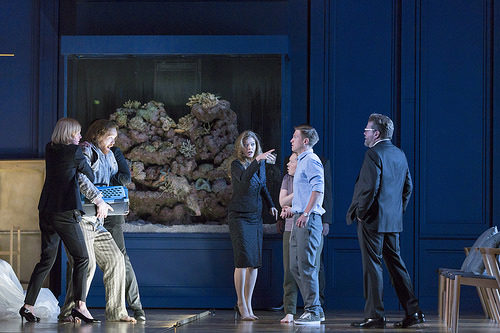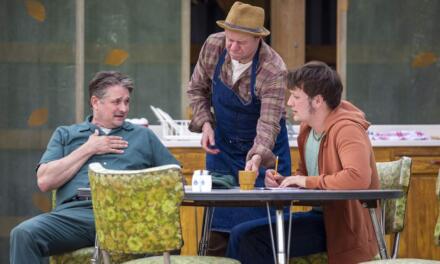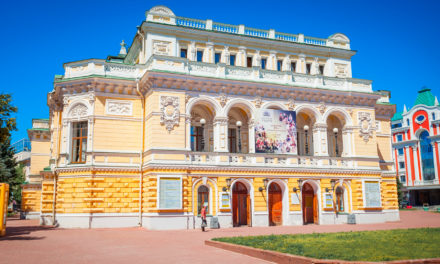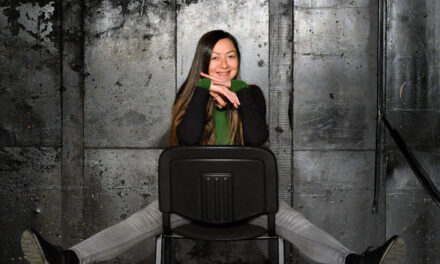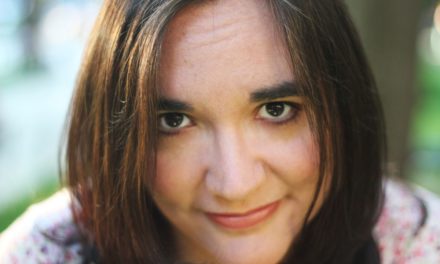Katie, or rather, Katrina Jane Mitchell, is a leading British theatre director whose creative drive seems to be truly inexhaustible. Early in her career, she worked for the Royal Shakespeare Company. In 1996 she won the Evening Standard Award for Best Director. The Department of Theatre and Performance at the Victoria and Albert Museum invited Mitchell and Leo Warner of 59 Productions to conceive and produce a video installation exploring the nature of “truth in performance.” This multiscreen video installation launched at the Chantiers Europe festival at the Theatre de la Ville in Paris on June 4 and opened at the V&A on July 12, 2011. She has been described as a distinguished British director who is also perhaps the most “Russian” in her approach towards the stage, as her creative process implies long and intensive rehearsal periods and use of the Stanislavsky “system.” She regularly involves psychiatry in looking at characters, and in 2004 directed a series of workshops on Stanislavsky and neuroscience at the NT studio. Her frequent collaborators include writer Martin Crimp and designer Vicki Mortimer. She has recently staged her controversial and much spoken about Lessons In Love And Violence at the ROH—a darkly dramatic new opera. However, our major interest lies in tracing it all back to her love of Russian theatre and film.
Yulia Savikovskaya: When you think of ways of expressing yourself in art, how is a theatre director different from a painter, musician, writer, actor?
Katie Mitchell: (Laughs) You are from Russia, you are going to ask very difficult questions, metaphysical ones. How is it different if I were a painter or a musician? Well, I don’t know, because I am not a painter or a musician, so I can’t make the comparison. But I suppose, the thing that I most wanted to do when I was little was to paint. So, when I first made theatre, it was a response to a failure to paint. I was always very interested in the image. And then, of course, I realized it is not good to be only interested in the image. You have to be interested in actors and lots of many other things. But even now the image is the thing that drives me, and then there has to be a robust intellectual idea underpinning what I am making.
YS: Do you think you were influenced by being born in the UK, or is theatre director an international profession? Is everyone influenced by the country they were born in?
KM: I don’t think I was very influenced by the country that I am born in–in terms of the conscious influences on the work that I make. So–I don’t know why–but I was always drawn to international work that came into England. So, when I went to the Edinburgh Festival, I was always seeing Polish or Russian companies, and then there used to be very big festivals, also in London. So I remember seeing Anatoly Vassilyev’s Serso–I found that work more interesting. And so, when I wanted to really learn about my craft, I, therefore, went to Russia, Georgia, Poland, and Lithuania to learn it, because the work that I’d seen that was coming from that part of the world was the biggest influence on me. And also film–a lot of Mosfilm–like Klimov, Klimov’s wife, Tarkovsky obviously. I don’t know why, but they were the big influences on me.
YS: It actually seems that at that time the theatre scene in England was more international than it is now, is it true?
KM: Yes, it was. There was a lot more work coming in. So there was London International Festival of Theatre, and there was a place like Riverside Studios, and even they and the National Theatre were having international seasons all the time–with shows coming from Eastern Europe, Western Europe and also from America. So, I was much, much more influenced by work from abroad.
YS: You always mention your trip to Russia as a definitive one in your early career. Could you speak more about it–was it a month, two months or a year? How did you spend your time?
KM: Actually, it was very short. I spent a lot of time in Poland, but less time in Russia. I think it was 6 weeks. I must have spent two or three weeks in Moscow, two or three weeks in St. Petersburg, and then a couple of weeks in Georgia and couple of weeks in Lithuania. So–no time at all. But–I left two weeks after the Berlin wall had fallen. So, every single rehearsal–all the doors were open. You could meet the most important artists everywhere. I remember being in Poland and watching Vaida rehearse, and then Vaclav Havel turned up, because he has just got a new job, and so then we sat and had tea. Politically, it was a big moment, and artistically it was very big. As I understood it, the tradition of resistance and the artistic practice that built up all the way from Stanislavsky through to 1989 when I went, was really strong. So, I suppose, I must have seen the show every night. I have my diaries, actually–I got them out very recently, just to get my archives together. And I literally watched a show every night–amazing work, really amazing. So, I saw a lot of brilliant theatre, and then in Moscow, I met Vassilyev, and he was the most important influence. I had to fight to get into his world, as he wouldn’t let me in. But then I watched him direct his own professional actors, the work he made, and I also saw how he worked with young people, GITIS students. And then in St. Petersburg, I did the same with Dodin. So Vassilyev and Dodin were really big influences on me. It was also because I had access to their process, and so I began a search to really understand their work. The work that Dodin practiced was shaped by Stanislavsky, and then it was passed to Tovstonogov, and from Tovstonogov it passed to Dodin. So, I was quite close to Stanislavsky in this way. There was a lot to absorb on that trip. And all the time I had an interpreter, as my travel grant included the fee of the interpreter. So, I opened the door on the way of making theatre that I then spent twenty years trying to really get to the bottom of–which is Stanislavsky’s practice interpreted by Dodin. And then I worked later on with one of Dodin’s actors–Tatyana Olya, who had left the ensemble and worked in Italy. So it started with an emotion that concluded finally in the book that I wrote–The Director’s Craft.
YS: Dodin has the practice of one or two-year rehearsals–the method you definitely did not adopt in your work.
KM: Exactly, not at all. But what I saw Dodin do, is to work with young directors, so what I saw them do is to train people, watch, and then give really clear instructions to performers. And that is the way of practice in the rehearsal room that is brilliant–so, it was not so much about the length of the rehearsal period, as I wasn’t there, as you see, for long enough. But when you watch someone work with directors, everything is compressed. So I would not copy how he used time, but I copied what he did in that time–the level of how he looked–it was so forensic, so detailed, so precise, it was breathtaking. And I wanted to learn how to be able to look at the process like that and to give very concrete instructions.
YS: You said, you were influenced by image, but with him, the text is of primary importance–did you also shift your attention to text after seeing Dodin work?
KM: The thing that is difficult with being in this country is the fact that the text is the dominant theatrical focus. And so, I resisted being involved and engaged in that. I would always feel that I am interested in behavior and the construction of life-like behavior, but not the delivery of the perfect text. These are such different things for me. And Dodin helped me understand how to construct life behavior on stage. But I wasn’t really engaged in how he was focusing on text, because I wasn’t interested in it. I like to look at psychology and image, I don’t like to listen to words. And that issue means that it will always be not fitting inside my own country. And also, because I am not a Russian speaker, I could not appreciate Dodin’s subtlety with language, I could not read that.
YS. Speaking about that ability to deliver life behavior on stage, is it why Chekhov fascinates you? You spoke once about the radicalism he introduced to the stage in being able to do that.
KM. Exactly, the fact that he was a doctor is the most important thing to know about him. Well, two things–one that he wrote short stories and he really understood the compressed form. And two–he was a doctor, and this is most important. When he is talking about character, he can construct character in a quite scientific way. He is quite scientific. He is able to read depression and pathology, he studied a lot of psychology, as well, early on in his career. So, he constructs character not in a literary way, but in a more scientific way, and then he has got this fantastic compression skill of a short story, so he can compress very brilliantly. But I think, yes, that doctor aspect of his personality has always appealed to me. So, whenever you interrogate any of the characters, you can rotate them and they all are 360-degrees built. They are not literary, they are flesh and blood.
YS. You also mentioned in one of your interviews about Chekhov that you try to cut all historical things in the plays that are linked to a certain period of time. Is it a way to make his plays international, without any Russianness?
KM. Maybe it is, that’s an interesting point. But I think I did it because I wanted–you really feel when you research Chekhov, all the radicalism of what he did. In this country there is a tradition of doing Chekhov which was built in the 1970s: a very sort of slow, country gardens and it feels very Victorian. Those 1890s costumes in Russia–we love the costume drama, Downton Abbey TV series, the escape to this world. We got slightly stuck in this country with how we present Chekhov. Actually, we were making Chekhov look like Victorian England. But slow. So, I always sensed the radicalism and the fire in his plays. They are not realistic, they are symbolic—most of them. So I thought–if I removed the 19th-century theatrical conventions, just cut them all out, it would make them more radical. I did do that with writer Martin Crimp, with The Seagull, and then people got really, really angry, it was incredible.
YS: Maybe it is because here Chekhov belongs to the naturalist theatre tradition, right? Maybe it had to do with you putting him on a different level?
KM. Maybe, but it was still very naturalistic, really naturalistic. There was no heavy symbolism, it was a very life-like naturalism. And even things like The Seagull–we put a seagull in a box, so we just delayed seeing the seagull till the moment that Treplev mentioned it and lifted the box–and then we saw the seagull. We just did things that would sharpen the ideas and would make them sound as radical as I think they must have felt at that time. But you know, the interesting thing with that show was (I then did the exact replica of that show in Denmark, and the reviews–you should read them if you really want to understand the differences between the two societies–it was an identical show), I just made it with Danish actors. And they talked about the fact that it breathed life back to the radicalism, so they received it completely differently, I think it won the best production. Whereas here–everyone was appalled (laughs).
YS: Comparing your British and non-British experiences–was there a way for you with Chekhov? How did you develop through directing him? From your personal encounter with him to the Cherry Orchard you did several years ago at Young Vic?
KM: I don’t know. The thing is that I started directing Gorky. So I went via Gorky to Chekhov, doing Vassa Zheleznova and then the last ones of his play. And when I was in Russia in 1989, I went to Melikhovo, studied Chekhov’s plays. To begin with, I was very afraid of directing them. So I did not direct them until later in my career. I went in 1989, but I was not doing Chekhov until late 1990s or even early 2000s. I was very cautious–I knew how difficult and complicated they were. I was literally very afraid of Chekhov. And then at the National Theatre, I staged a lot of Chekhov’s plays. I should not have done Cherry Orchard, though, because my interest had passed. Sometimes that happens. My staging of Chekhov’s plays was very much linked to my investigation of Stanislavsky’s techniques as I interpreted them, and then it was linked to the writing of the book. And then suddenly I started doing multimedia work, and that took me on a different direction, and then on top of that I moved outside the UK–started to work in Germany, France, and Holland. As a result, my appetites for doing Chekhov had faded, and I wasn’t aware they did until I started to work on the Cherry Orchard. And also, I did it in the wrong country. So I’d been out of the UK, I felt very much I was in exile, forced out. Therefore, when I was coming back, I was a bit nervous and did not wish to be too radical. I was trying to position the production too carefully. I should have done it like I would have done it in Germany, although, in fact, I never would have done it in Germany.
YS: It is a good point to move to your other work and your continuous involvement with three countries– the UK, Germany, and France. I wanted to ask you about your multimedia productions. It is interesting that in the book you are so focused on the discovery and analysis of the text. But when I saw your shows The Waves and Attempts On Her Life at the National Theatre Archives, I realized that what audiences are seeing is not text, it is a collage of multiple sounds and images.
KM. That brings us back to the beginning of our conversation when we were talking about the late 1980s and early 1990s and about possible national influences. So, of course, there was Eastern European influence, but there was also American influence, from companies, such as the Wooster Group, and then British influences from the 1980s groups like Hesitate And Demonstrate, Impact. They were avant-garde theatre practitioners, doing a lot of work with video. And in the 1980s, these were two influences working on me. I focused very much on Russian theatre, Stanislavsky, and the text, and I sat on this for 20 years, but there was still an outstanding interest in radical forms stemming from the 1980s that I still had in the back of my mind and I have always wanted to do, and that was how I started doing it. Even though I have been waiting to do this for 20 years. We’ve done about 20 multimedia shows by now, and the technique is much more sophisticated compared to that in our first shows – Attempts On Her Life [based on a play by Martin Crimp]. Then it was quite rough. Now we have a very complex film technique.
YS: Does it mean that you as director have been evolving with the introduction of the new media and techniques in the field? Did you follow the new developments in this sphere, in technology and then decided to use them in your shows?
KM: No, it all started because I really wanted to do Virginia Woolf’s The Waves. But secretly I also wanted to get away from naturalism and into other forms. I have always found that theatre was out of sync with visual arts. We had no cubism and not so much surrealism. Thus, I was searching for other genres, other ways of staging the production. And this is how I took an impossible book, which is all about thoughts. There is no dialogue in The Waves, it is just about people thinking. I set myself the most impossible place to do the most impossible task–thoughts. Not a monologue, it is just literally thoughts. How do you do thoughts? And have put the camera there [shows by the hand] and the voice-overs were the thoughts. And it was so exciting for me, as that was another step in my interest in psychology and behavior because you could do consciousness, and that was more interesting. You could get inside the head, you could do subjectivity, you don’t have to look at everything as an objective documentary shot, you could actually get inside people’s heads. So I think that really interested me. But I don’t know anything about technology to the extent my team does. So I just kept saying–”oh let’s do this idea,” and then they responded: “oh, we shall use this equipment.” So it was all–it’s the same quality in tone and texture and the acting as in naturalism—the same thing, but I could get closer to the subjectivity, closer inside someone’s head, which is one further step in terms of representing what it is to be human.
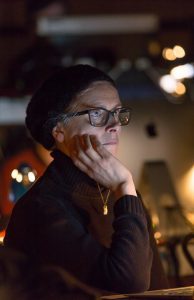
Katie Mitchell. Photo @ Stephen Cummiskey
YS: Actually, this is exactly what I wanted to ask about. In your view, are there specific areas of human experience that theatre is particularly good at capturing. Still, what are its limitations?
KM: You can’t get into a head very easily, can you? We think when we watch an actor standing and doing a monologue–a Hamlet monologue–that we are inside the head, but we are not, because the interior of the head is more chaotic than that. So I think the theatre is limited, yes, it can’t do what film can do in terms of subjectivity. But that’s something I’ve been pushing to explore, how subjective can it be, can you get inside someone’s head and look out at the world from that perspective instead of standing outside and looking, like a documentary maker, at the behavior, and guessing what’s inside? Can you get inside and know what’s inside? And that, of course, is such an interesting frontier.
YS: Do you think the audience should be prepared to grasp all these different subjective and complex meanings? Would other countries like Germany be better for your explorations, as they have better-prepared audiences to your innovative theatre experiments?
KM: Definitely, German audiences in German theatres are more interested in this radicalism. And therefore they pushed this investigation much further than I ever would have imagined or would have been able to do in this country. So I started working there out of necessity–I had to earn a living, I had a child–and I ended up there doing my most radical work, and I think the environment definitely pushed me further and really encouraged the investigation in a very extreme way. I remember when Schaubühne started to have a conversation with me after my first production in Cologne, they said: “’we really need a title, like a well-known play.’ And I said: ‘What about Miss Julie?’ and they said ‘Yes, ok.’ And I asked ‘Are there any rules about how I am to do it?’ and they said: ‘No, not at all.’ So I cut 80 percent of the text and did only the scenes from the point of view of the least important character, and they loved it. Whereas here (laughs) if you would do that, I think it would be hard for a lot of the audience, I don’t think they would enjoy it.
YS: Speaking about perception and understanding, is it important for you as a creator and thinker to be understood? There is a possibility of standing tall as an “ununderstood genius doing his or her work” and then there are people who really want to communicate their ideas to the society. So what is your standing?
KM: Well, I definitely don’t think I am a genius or anything like that, or that I need to be separate from people. Whether they like it or not, I want them to get a grip on the work that I and my team are making. It’s not that I want to be praised, I think one wants the work to be clear and understandable to the audience. The ideas behind the work or the concept and the formal experimentation should also be appreciated. Whether they like it or not–I think that is a different thing. But it’s so tricky, isn’t it? For when you are the person who is making it, it is so different from a person outside observing its evolution. Now I am making this show, but I am also preparing about 5 or 6 other pieces of work. So I don’t operate linearly, I operate more three-dimensionally, I don’t have the perspective that you have on it. However, I certainly feel that I have to be accountable for it intellectually. (laughs). It has to be high quality, and it has to be strong ideas, a very thought through work. Yes, it should be thoughtful.
YS: How personal do you permit yourself to be? Some performers or writers often offer some kind of an autobiography in each their work, while others approach their works more intellectually and research into a particular subject. What is your approach?
KM: I am sure that inside your proposal there is also what we are conscious and what we are not conscious of also going on. I think when you start you are not conscious of what you are doing in relation to your own biography. But of course, as time passes, you become conscious of patterns in terms of the content and the way you are doing things. And then you have to interrogate those things and ask yourself whether there is a sense in which you are imposing irrelevant autobiographical information on audiences or material. And then there is sort of a jungle that you have to pass through, and then you emerge–conscious of everything that you are doing–and you are consciously choosing to investigate this type of material or that type of material. So, for example, I consciously chose in my late 40’s–early 50s to really focus on female experience. I thought that as long as I could work, I am just going to do that. And I am also going to try and increase the canon of material that can be thought of as being theatrical, like adaptations of Marguerite Duras, for instance. So, I am going to say–let’s just keep looking at female experience and get more playtexts available that are not normal playtexts. So I am very conscious of doing that now.
YS: I liked it when you encouraged your female colleagues to think what was right for them, and in a woman, this voice is always subdued. So, in your view, in which way a female experience of being a writer or a director differs from the general human experience as we are used to thinking about it.
KM: I am just re-reading Simone Beauvoir’s The Second Sex now, and she quotes a feminist in the book saying that she just wants to have the right to be a human being. I think the problem is that some women feel that they are classified as women, not human beings, and that classification is different from men’s experience. Men don’t get to be classified as men as much as women do. For me just equality is important. I was brought up in the 1970s, the second wave of feminism, and that was a real push for economic equality. Equality is the base note of every society. And that really interests me. Now we are in the fourth wave of feminism, and we are in a much more nuanced territory. And I know that there is a limit to the area that I investigate. I am doing cis men and cis women inside patriarchial structures. I am not presenting alternative ways of imagining gender–trans and all those things. I am not investigating it, but I find what I am doing extremely important. You know in the 1990s someone changed “his-tory” into “her-story” (laughs), and there was this little movement about “her-story.” And when I was telling about it to my 12-year-old daughter, she was very pleased (laughs). I think there is still a lot of work to be done. And now when I am a senior female artist, both in this country and elsewhere, I have to be responsible for that. I have to take responsibility for the fact that I am one of the very few women working at this level across these fields. I perceive it as a political and moral responsibility.
This article originally appeared in Russian Art and Culture on July 7, 2018, and has been reposted with permission.
This post was written by the author in their personal capacity.The opinions expressed in this article are the author’s own and do not reflect the view of The Theatre Times, their staff or collaborators.
This post was written by Yulia Savikovskaya.
The views expressed here belong to the author and do not necessarily reflect our views and opinions.

